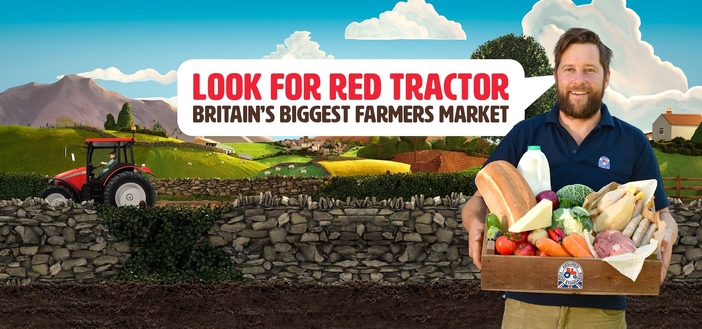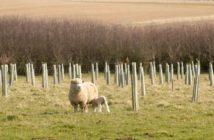The UK’s leading farm assurance body, Red Tractor, is urging farmers to engage in a consultation on how its farm standards should evolve.
A consultation opened today with proposals put forward on how the standards should look across the scheme’s six sectors; beef and lamb, poultry, pigs, dairy, fresh produce and combinable crops and sugar beet.
Red Tractor is seeking input from across the industry before finalising its proposition of what the schemes standards will be from November 2021.
The proposals have been developed over 12 months. At every step of the process, representatives from across the food chain – farming organisations, farmers, vets, processors and retailers – have been fully involved in drawing up the amendments.
Together they have studied consumer trends,reviewed the latest science and evidence, as well as benchmarked the scheme against competitors and industry best practice. The three-stage process of committee, consultation and consensus, adheres to gold standard recommendations of the British Standards Institute.
CEO Jim Moseley said: “We are a proven world leader in food chain assurance, but we cannot rest on our laurels.

Jim Moseley
“Red Tractor is recognised as a symbol of British food quality but to maintain this, our standards must continue to evolve with the times, to ensure they address changes in legislation, industry practice and reflect the emerging issues on shoppers’ minds.
“At a time of ever-increasing scrutiny, preserving the public’s trust in UK agriculture and the Red Tractor logo has never been more important.
“These proposals strive to strike a delicate balance which protects and promotes our members, reassures consumers and customers, while acknowledges the implications of the challenges that the industry faces with future trade deals and the agricultural transition plan.”
The proposed amendments tabled by Red Tractor are primarily about streamlining, legislative compliance and responding to change. These include simplifying some of the requirements for farmers to drive greater understanding and compliance, and rationalising standards which are common across multiple sectors, providing improved clarity for both farmers and their assessors.
Red Tractor has also listened to British consumers and the recommendations made in a review of the scheme by Dr Jonathan Birnie in 2019, which identified limitations in the current standards around animal and worker welfare and environmental protection.
Examples of proposed changes in these areas include:
Animal Welfare: Having welfare outcomes linked to standards. This includes housing structure and cleanliness and making it absolutely clear what is and isn’t acceptable when handling animals.
Worker Welfare: The Red Tractor strapline Farmed With Care includes care for the people on members’ farms. UK agriculture’s health and safety record is poor and farming is identified as an at-risk sector for labour exploitation. Building worker welfare into the standards ensure members are taking sensible steps to protect the safety and wellbeing of workers on farm.
Environmental Protection: The inclusion of the Farming Rules for Water, which are already legislation and aim to reduce soil erosion and nutrient run-off. The requirements have been adapted from the legal requirements to ensure they are meaningful and can be easily assessed.
The full list of proposed changes, supplementary documents on why Red Tractor has reached these decisions and on how to respond to the consultation can be found on the Red Tractor review hub at https://assurance.redtractor.org.uk/.
The full consultation can be accessed at https://redtractor.citizenspace.com .
A short video explaining why Red Tractor needs input from the industry has also been created here.
In addition to reviewing its standards, Red Tractor is also asking members and stakeholders for their views on what matters to them and their business.
Mr Moseley added: “Farmers have been an intrinsic part of the process in drawing up the proposed new standards, but now it is over to the membership and stakeholders to have their say.
“Red Tractor was created to become a symbol of trust, safety and responsible production. Twenty years on, our purpose remains the same and we are absolutely delivering on it.
“Millions of shoppers look for the Tractor when they are buying food and drink. And consumer trust has never been higher, making us the most trusted food marque in the UK.”
The consultation and review closes on 5 March 2021.
Proposed amendments to standards by sector
Fresh produce
Structure
Members will see a new framework to the standards. There will be 10 core sections
which apply to all farms, five operational area-based modules (assessed only where relevant) and two crop-specific modules. There has also been a reworking of the produce handling and packhouse packing section to allow this to cover rig-based packing operations and streamline assessment where a valid BRC certificate is held.
Risk management
Existing standards have been reviewed
to take into account site risk assessments and post-harvest water management. Additions have been made to reflect new growing techniques and non-traditional cropping systems such as vertical farms and hydroponics
Legal compliance
There would be new standards for
the management of nitrate concentration in crops where legal parameters apply and two new standards to cover post-harvest treatments in the post-CIPC era.
Food safety
Several new standards are proposed to further strengthen food safety. They include daily start-up checks for harvest teams and two new standards concerning recirculation and re-use of post-harvest water.
Combinable crops and sugar beet
Risk Assessment
This would appear as a new section
on the standards but brings together
a number of existing requirements into one area for clarity.
Irrigation
A number of revisions have been proposed, all with the aim of providing clarity on what is required where a member is irrigating crops.
Environment
Some changes to the storage of plant protection products have been outlined based on best practice.




